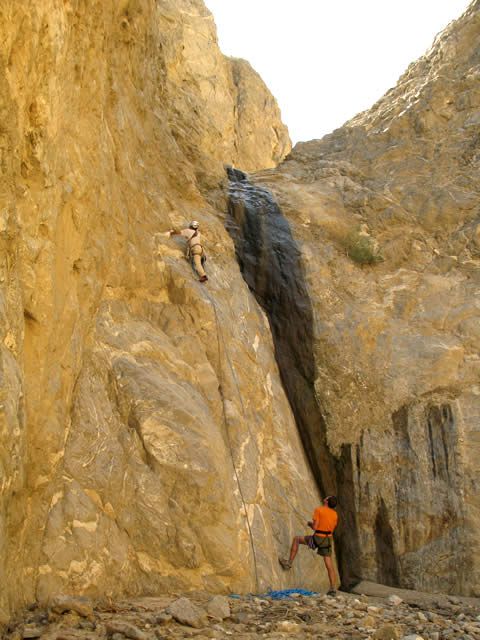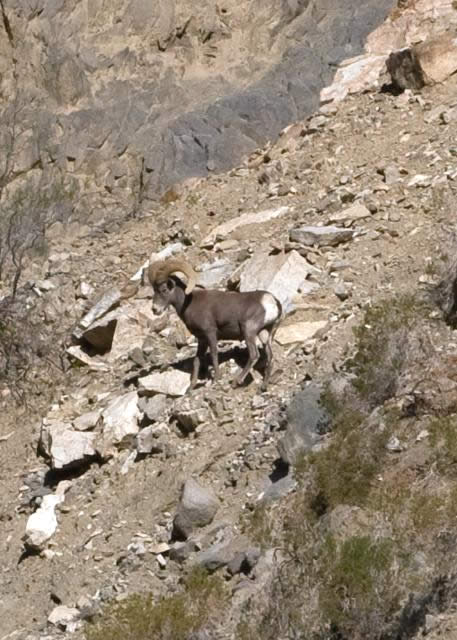![]() News.bytes Extra, issue
356
News.bytes Extra, issue
356
Upper Pat Keyes Tamarisk Removal 2008
For three years now, BLM-California’s Ridgecrest Field Office has been working with Friends of the Inyo and Desert Survivors on removing tamarisk from Pat Keyes Canyon. The canyon is on the east side of the Inyo Mountains, in the Saline Valley. At first, our teams concentrated on tamarisk within easy reach -- from the base of the 75-foot waterfall in Saline Valley, out to the Saline Valley road. We used several different techniques, from hand-pulling and weed wrenching to foliar spraying and painting cut stumps with herbicide. So far, it seems these techniques have been remarkably successful.
However, we were always mindful of the tamarisk peering at us over the top of the 75-foot waterfall. We concluded we had to find out the extent of the tamarisk infestation in Pat Keyes Canyon above the falls. In September 2007, four of us (Todd Vogel, John Drumm, Tom Budlong and Marty Dickes) backpacked up the Pat Keyes Trail from Reward in Owens Valley to the crest of the Inyos and then bushwhacked down Pat Keyes Canyon. We encountered seventeen 25- to 150-foot falls, six of which we were able to climb around, and eleven that we had to rappel down. Tamarisk was found at 4,150’, after only the third fall. The question: how do we get work crews into the areas between the remaining falls, to remove the tamarisk?
Getting up the canyon meant climbing rock walls. Here, one
of the team places anchors alongside the first waterfall:

This fall Todd Vogel of Outdoor Link, with the help of climbers John Drumm and Tory Robinson came up with the answer. Todd and John climbed the falls from the bottom up, installing bolts and anchors for fixed lines and belays to be used by volunteers a week later. Tory and I followed, testing the ascenders and cinches for use by climbers and non-climbers like me! On the first day of the service trip, volunteers were given a harness and helmet and taught the rudiments of climbing, using ascenders and cinches, and of down climbing and rapelling using cinches and rapell devices. In subsequent days, Todd and John stationed themselves at critical points to belay and coach people up and over the falls to remove tamarisk and to belay and help people back down to our base camp at the close of each day.
Volunteers first had to learn the rudiments of climbing.
Here, Todd Vogel describes equipment to volunteers:

Handsaws, clippers, personal protective equipment (Tyvex® suits, rubber gloves, goggles), hand sprayers and herbicide (packed undiluted in nalgene bottles inside dry sacks) were hauled up in packs. Herbicide mixtures were mixed on-site in spray bottles using stream water filtered through bandannas. As Habitat® is used in small quantities in diluted form (10% Habitat to 89.5% water with 0.5% Agri-Dex mixed in), we carried only a small amount of active ingredient with us. This saved weight and minimized risk of spillage during transport.
Marty Dickes outfitted with protective gear for
spraying

A July thunderstorm had sent a severe flashflood down the canyon, wiping out perhaps as much as half of the tamarisk in the canyon inventoried a year earlier. During the first week, Tory, and I were able to treat most of the tamarisk between the 1st and 3rd fall. Todd and John concentrated on the uppermost part of the infestation between the 10th and 17th fall where the climbing was most difficult, treating about 80% of it the first week, finishing it during the second. As the bulk of the infestation was between the 4th and 9th fall that’s where we placed six volunteers during the second week of the project. We broke into two-three teams each day depending on the size of the infestations and the obstacles between them. We finished treating the infestation totaling 15 acres in four days.
A volunteer takes to the slopes, as team members hold the
ropes

A volunteer makes his way up the wall


Climbers shared the slopes with this bighorn, spotted
during one of the climbs

A team member stands by tamarisk after treatment

- M. Dickes, 10/08. Photos by Nick Jedenoff, Todd Vogel and Marty Dickes.
BLM-California News.bytes,
issue 355